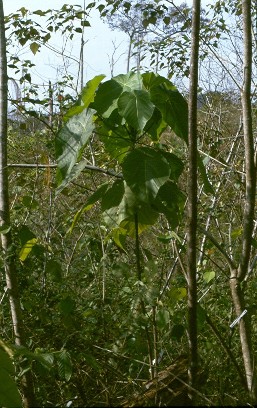Macaranga tanarius (L.) Műll.Arg.
Shrubs to small trees up to ca. 27 m tall and 45 cm dbh, reproductive from 4 m tall and 5 cm dbh. Twigs solid, glabrous to hairy (short simple hairs), usually not glaucous. Stipules ovate to triangular, semi-persistent, erect to spreading, not surrounding the twigs completely, 10-29 mm long by 4-12 mm wide. Petioles glabrous to hairy, up to ca. 22 cm long. Leaves alternate, ovate, peltate, 12-36 cm long by 7-28 cm wide, length/width-ratio 1.2-1.86; secondary veins 7-10, ending in the margin; leaf base broadly rounded, peltate leaf margin 1.8-9 cm; leaf margin with glands; leaf upper surface glabrous to hairy on veins; leaf lower surface glabrous to densely hairy, rarely glaucous, sparsely to densely gland dotted. Staminate inflorescences branched; flowers clustered per bracteole; bracteoles with fimbriate margins. Pistillate inflorescences branched, with rather large leaf like bracteoles; fruits 9-10 mm wide, 2-locular, with few long spines, completely covered with glands.
Ecology: Collected up to ca. 1400 m altitude. An early successional species, mostly restricted to severely degraded forests or open grasslands. Very rare in primary forests.
Distribution: A very wide spread species occurring from India and South China to the Western Pacific and Australia. In Borneo it has been collected throughout the island, but most collections are from Sabah, East- and South-Kalimantan.


